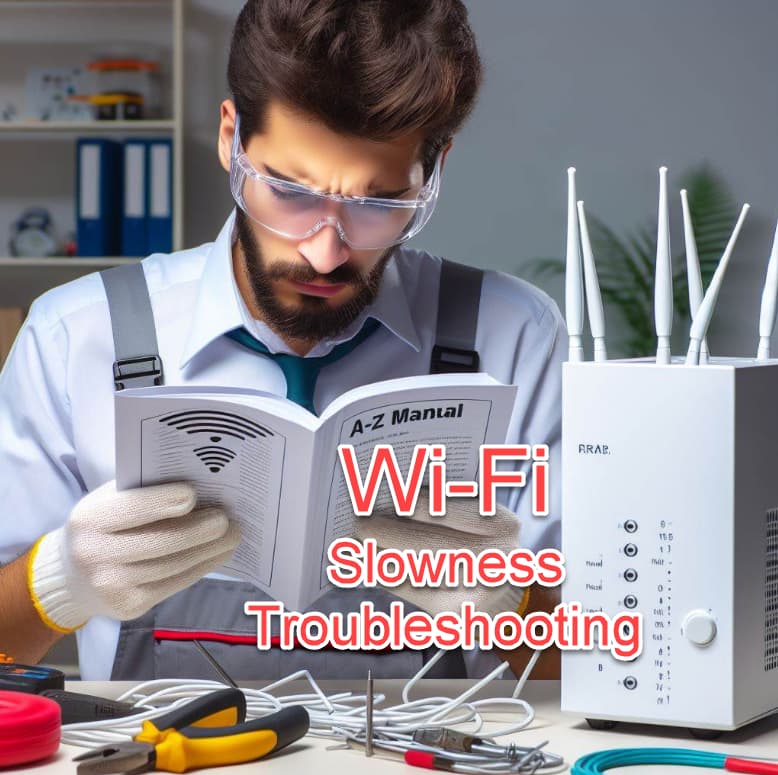-
A. Assess the Situation
Start by understanding the scope of the problem. Is the slowness affecting all devices or just one? Is it limited to certain times of day? -
B. Bandwidth Check
Use an online speed test tool to check your internet speed. This will establish a baseline for comparison later. -
C. Close Background Applications
Make sure there aren’t any bandwidth-intensive applications running in the background on your device that could be consuming your network resources. -
D. Distance Check
Verify the distance between your device and the WiFi router. Walls, floors, and other obstacles can weaken the signal. -
E. Ethernet Connection Test
If possible, connect your device directly to the router using an Ethernet cable. If the speed improves, it could indicate a WiFi signal strength issue. -
F. Firmware Updates
Check if your router’s firmware is up to date. Outdated firmware can lead to performance issues. -
G. Gateway Restart
Sometimes, a simple restart of your router and modem (if separate) can resolve connectivity issues. -
H. Hardware Check
Ensure that your router and modem are in good working condition. Faulty hardware can cause slow WiFi speeds. -
I. Interference Investigation
Identify potential sources of interference, such as other electronic devices or neighboring WiFi networks operating on the same channel. -
J. Jitter and Latency Check
Use tools to measure jitter and latency on your network. High values can indicate network congestion or other issues. -
K. Keep Router Elevated
Place your router in a central location and keep it elevated. This can help improve signal strength and coverage. -
L. Limit Connected Devices
Reduce the number of devices connected to your WiFi network, especially if they are not actively in use. -
M. Malware Scan
Perform a malware scan on your devices. Malicious software can consume bandwidth and slow down your connection. -
N. Network Settings Check
Review your router’s settings, including WiFi channel and security settings, to optimize performance. -
O. Overcrowded Channel Change
If you’re on a crowded WiFi channel, switch to a less congested one to minimize interference. -
P. Power Cycle Devices
Turn off your devices, router, and modem, then turn them back on after a few minutes. This can refresh network connections and resolve minor issues. -
Q. Quality of Service (QoS) Configuration
If your router supports QoS settings, prioritize traffic for essential applications or devices. -
R. Reset Router
If other troubleshooting steps fail, consider resetting your router to its factory defaults and reconfiguring it. -
S. Signal Strength Check
Use a WiFi analyzer app to assess the strength of your WiFi signal throughout your home or office. -
T. Traffic Analysis
Monitor network traffic to identify any bandwidth-hogging applications or devices. -
U. Update Drivers
Ensure that the network drivers on your devices are up to date. Outdated drivers can cause connectivity issues. -
V. Verify DNS Settings
Check your DNS settings to ensure they are configured correctly. Switching to a faster DNS server can sometimes improve speeds. -
W. Wireless Security Review
Make sure your WiFi network is secured with a strong password to prevent unauthorized access, which can slow down your connection. -
X. X out Unnecessary Devices
Disconnect devices that are not in use to free up bandwidth for devices that need it. -
Y. YouTube and Streaming Settings
Adjust streaming settings on devices to lower resolutions if necessary, especially during peak usage times. -
Z. Zero in on Specific Issues
If the problem persists, consider seeking help from your internet service provider or a professional technician to diagnose and resolve any underlying issues.
By following these steps, you should be able to identify and address the cause of your Wi-Fi slowness issues effectively.
